TimTaiLieu.vn - Tài liệu, ebook, giáo trình, đồ án, luận văn
TimTaiLieu.vn - Thư viện tài liệu, ebook, đồ án, luận văn, tiểu luận, giáo trình các lĩnh vực CNTT, Ngoại ngữ, Luật, Kinh doanh, Tài chính, Khoa học...

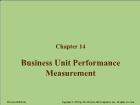 Chapter 14: Business Unit Performance Measurement
Chapter 14: Business Unit Performance MeasurementWe described the organization of the firm in Chapter 12 by referring to responsibility centers: cost centers, profit centers, and investment centers. In this chapter, we develop and analyze performance measures for investment centers. Recall that in an investment center, managers have responsibility for asset deployment in addition to revenue and c...
 17 trang | Chia sẻ: nguyenlinh90 | Ngày: 19/07/2019 | Lượt xem: 1081 | Lượt tải: 1
17 trang | Chia sẻ: nguyenlinh90 | Ngày: 19/07/2019 | Lượt xem: 1081 | Lượt tải: 1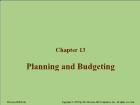 Chapter 13: Planning and Budgeting
Chapter 13: Planning and BudgetingA budget is a financial plan of the resources needed to carry out activities and meet financial goals. The budget ties together the goals of the organization, the plans for achieving those goals, the decisions that are made, and finally, the performance evaluation. By identifying a company’s critical success factors, those strengths that enable t...
 17 trang | Chia sẻ: nguyenlinh90 | Ngày: 19/07/2019 | Lượt xem: 1026 | Lượt tải: 0
17 trang | Chia sẻ: nguyenlinh90 | Ngày: 19/07/2019 | Lượt xem: 1026 | Lượt tải: 0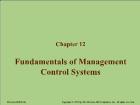 Chapter 12: Fundamentals of Management Control Systems
Chapter 12: Fundamentals of Management Control SystemsIn the previous chapters we considered how information could be developed to help managers make decisions. In this chapter we will discuss the fundamentals of management control systems.
 17 trang | Chia sẻ: nguyenlinh90 | Ngày: 19/07/2019 | Lượt xem: 850 | Lượt tải: 1
17 trang | Chia sẻ: nguyenlinh90 | Ngày: 19/07/2019 | Lượt xem: 850 | Lượt tải: 1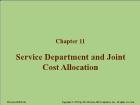 Chapter 11: Service Department and Joint Cost Allocation
Chapter 11: Service Department and Joint Cost AllocationWe have seen how cost allocation is used to develop the costs of products, services, and customers. However, part of the indirect cost incurred is from departments that do not directly produce the product or service but rather provide service to the departments that do produce the product or provide the service. In this chapter we will allocate the...
 17 trang | Chia sẻ: nguyenlinh90 | Ngày: 19/07/2019 | Lượt xem: 908 | Lượt tải: 1
17 trang | Chia sẻ: nguyenlinh90 | Ngày: 19/07/2019 | Lượt xem: 908 | Lượt tải: 1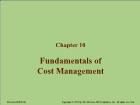 Chapter 10: Fundamentals of Cost Management
Chapter 10: Fundamentals of Cost ManagementActivity-based cost management uses activity analysis in decision making. In Chapter 9, you saw that activity-based costing focuses on activities. Activity-based management, on the other hand, focuses on managing activities.
 17 trang | Chia sẻ: nguyenlinh90 | Ngày: 19/07/2019 | Lượt xem: 955 | Lượt tải: 1
17 trang | Chia sẻ: nguyenlinh90 | Ngày: 19/07/2019 | Lượt xem: 955 | Lượt tải: 1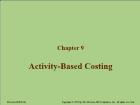 Chapter 9: Activity-Based Costing
Chapter 9: Activity-Based CostingChapters 7 and 8 described product costing systems. In the last 15 years or so, many companies have experimented with and implemented costing systems based on production processes rather than accounting systems. One such system is activity-based costing, or ABC, which aids managers in the decision making process. Chapter 9 describes activity-based...
 17 trang | Chia sẻ: nguyenlinh90 | Ngày: 19/07/2019 | Lượt xem: 983 | Lượt tải: 1
17 trang | Chia sẻ: nguyenlinh90 | Ngày: 19/07/2019 | Lượt xem: 983 | Lượt tải: 1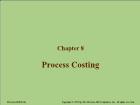 Chapter 8: Process Costing
Chapter 8: Process CostingWe continue our discussion of the details of a product costing system in Chapter 8 by developing a process costing system. As we discussed in Chapter 6, the difference between job order and process costing is the level at which costs are aggregated before they are assigned to the individual units of product. Process costing assumes that all units ...
 17 trang | Chia sẻ: nguyenlinh90 | Ngày: 19/07/2019 | Lượt xem: 808 | Lượt tải: 1
17 trang | Chia sẻ: nguyenlinh90 | Ngày: 19/07/2019 | Lượt xem: 808 | Lượt tải: 1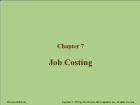 Chapter 7: Job Costing
Chapter 7: Job CostingIn Chapter 6, we developed the basics of a cost management system designed to report the costs of products and services. In this chapter we describe a job costing system used in many service and discrete manufacturing settings.
 17 trang | Chia sẻ: nguyenlinh90 | Ngày: 19/07/2019 | Lượt xem: 963 | Lượt tải: 1
17 trang | Chia sẻ: nguyenlinh90 | Ngày: 19/07/2019 | Lượt xem: 963 | Lượt tải: 1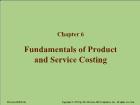 Chapter 6: Fundamentals of Product and Service Costing
Chapter 6: Fundamentals of Product and Service CostingThe objective of the cost management system is to provide information about costs relevant for decision making. The cost system accumulates and reports costs about processes, products, and services.
 17 trang | Chia sẻ: nguyenlinh90 | Ngày: 19/07/2019 | Lượt xem: 1029 | Lượt tải: 1
17 trang | Chia sẻ: nguyenlinh90 | Ngày: 19/07/2019 | Lượt xem: 1029 | Lượt tải: 1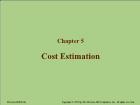 Chapter 5: Cost Estimation
Chapter 5: Cost EstimationBy now you understand the importance of cost behavior. Cost behavior is the key distinction for decision making. Costs behave as either fixed or variable. Fixed costs are fixed in total; variable costs vary in total. On a per-unit basis, fixed costs vary inversely with activity and variable costs stay the same. Are you getting the idea? Cost behavi...
 17 trang | Chia sẻ: nguyenlinh90 | Ngày: 19/07/2019 | Lượt xem: 800 | Lượt tải: 1
17 trang | Chia sẻ: nguyenlinh90 | Ngày: 19/07/2019 | Lượt xem: 800 | Lượt tải: 1
Website đang trong thời gian thử nghiệm, chờ xin giấy phép của Bộ TT & TT.

